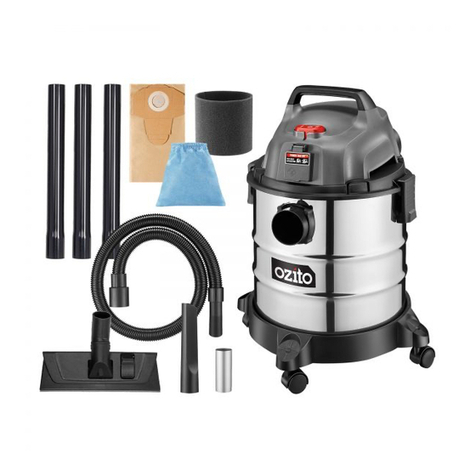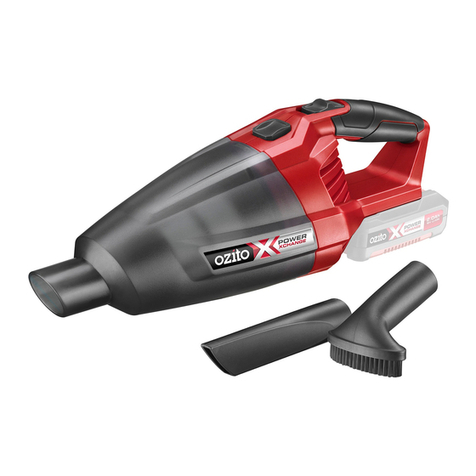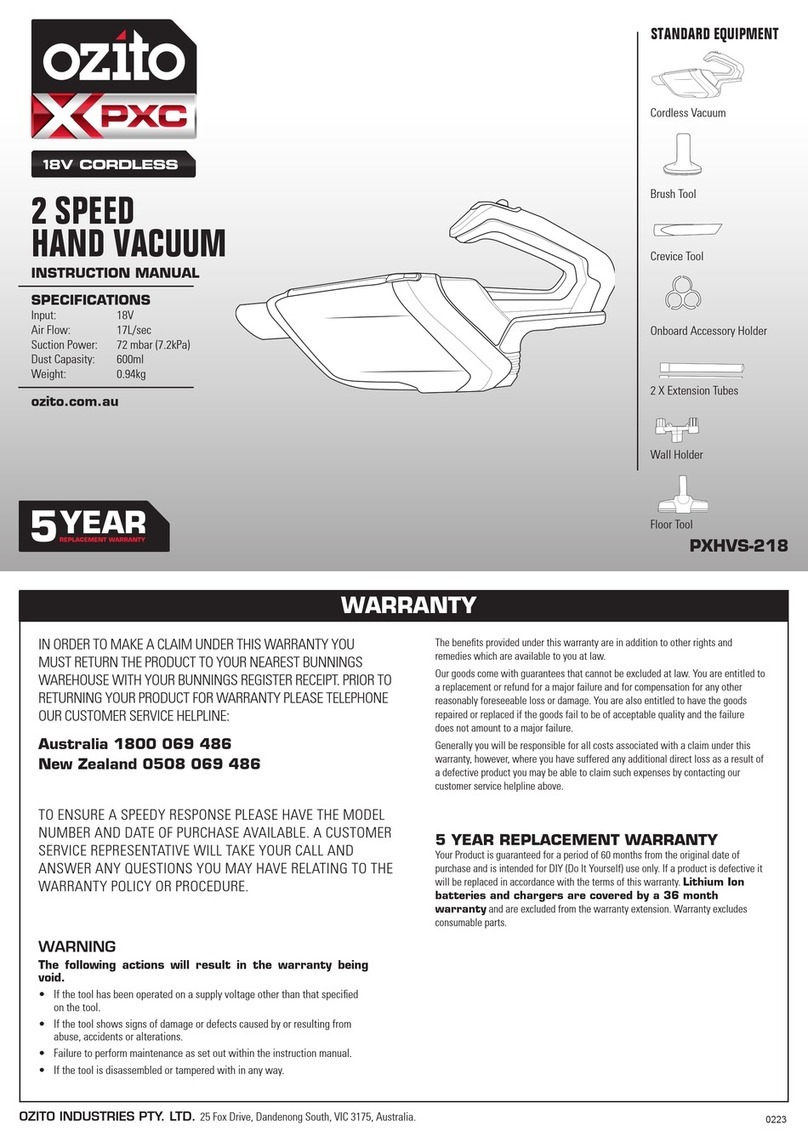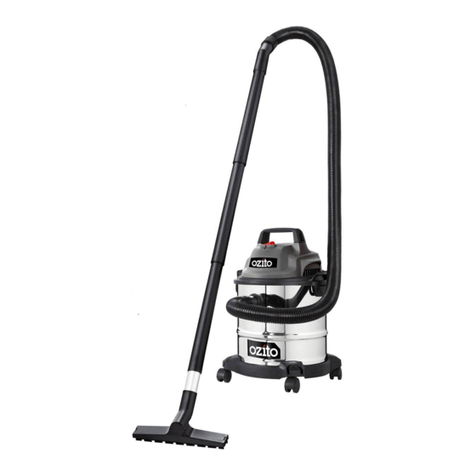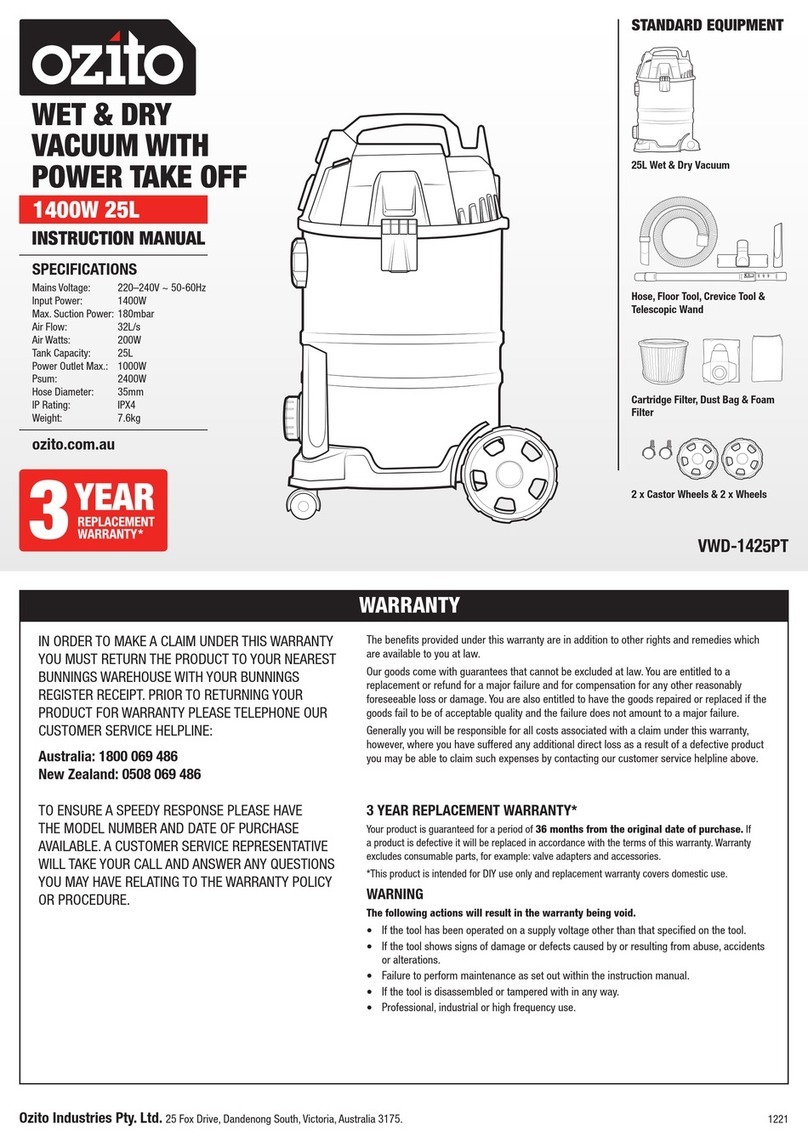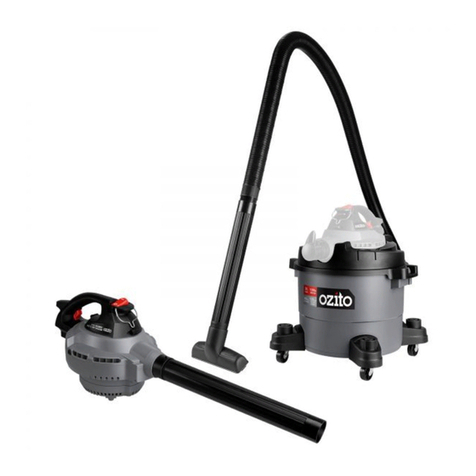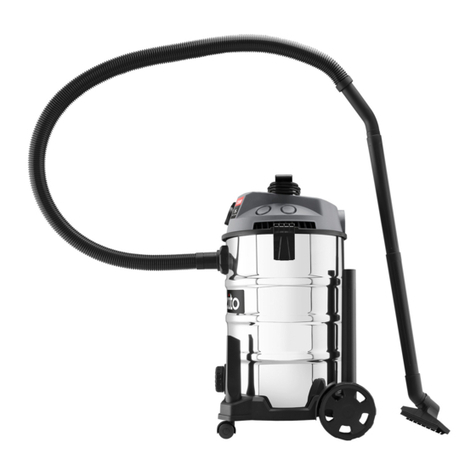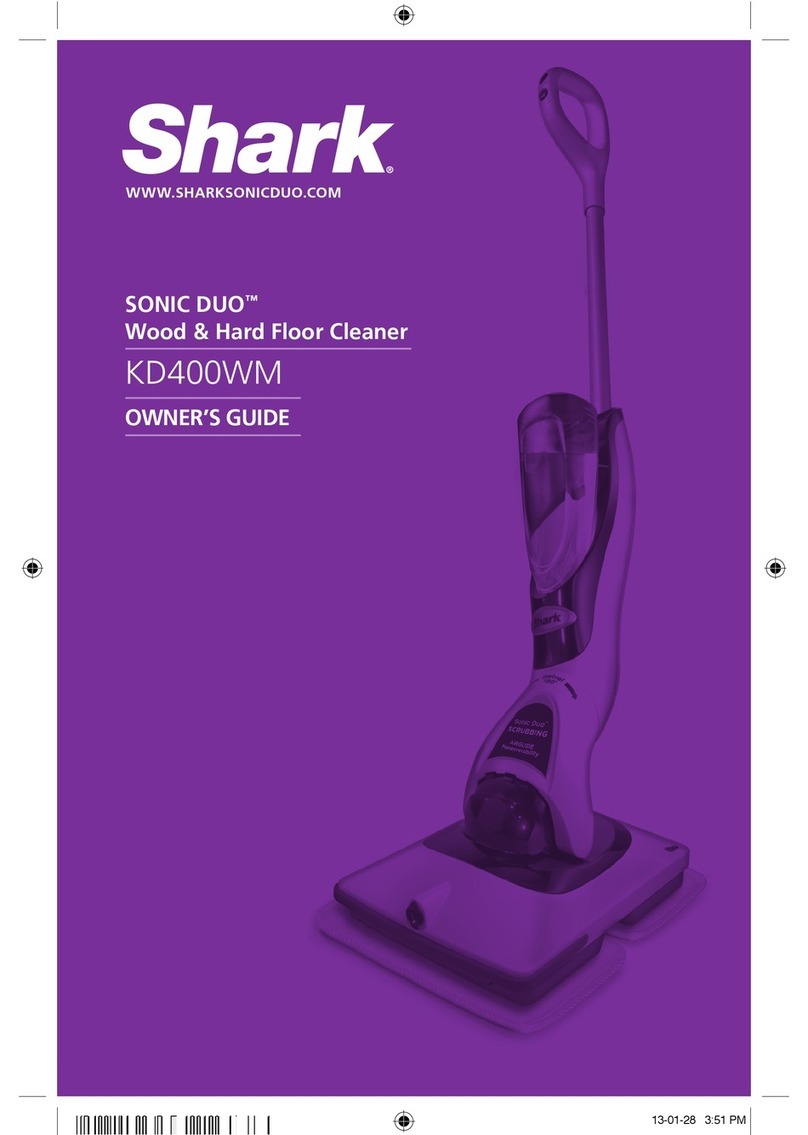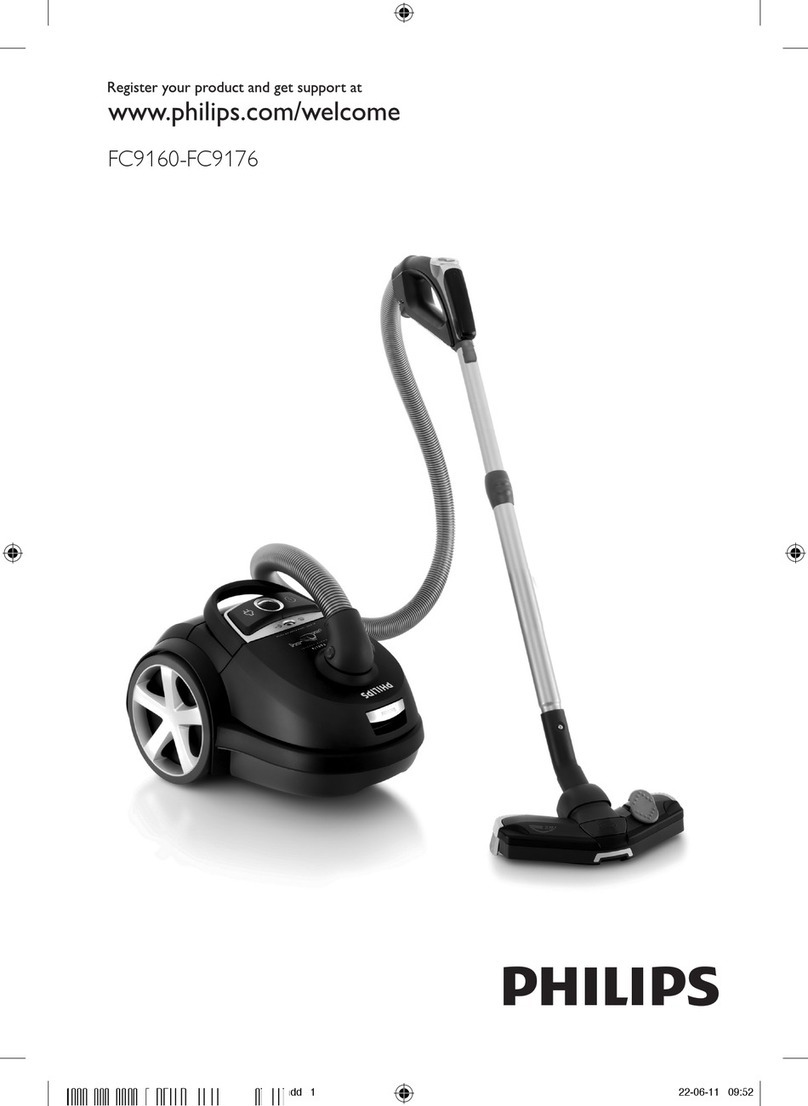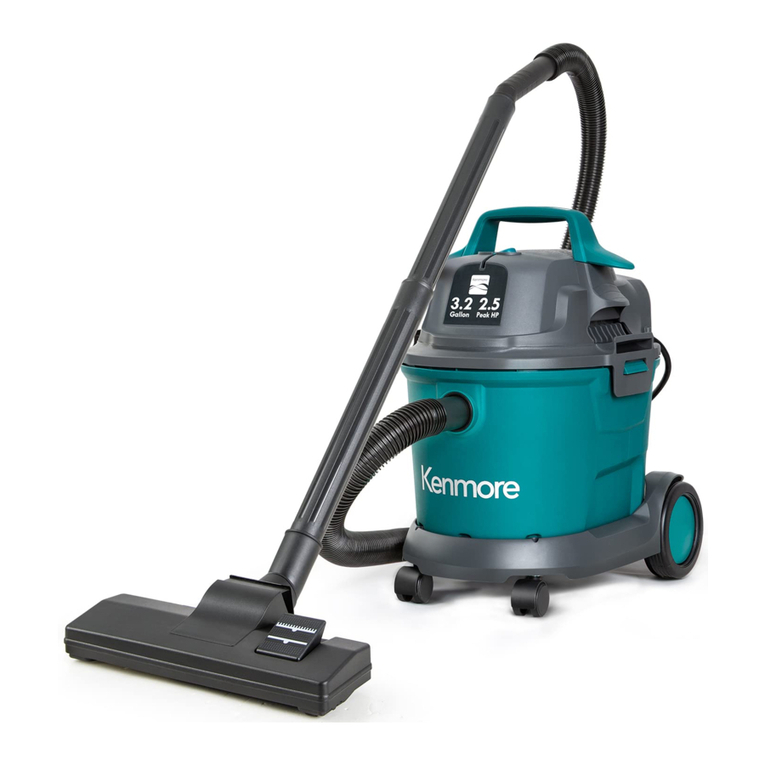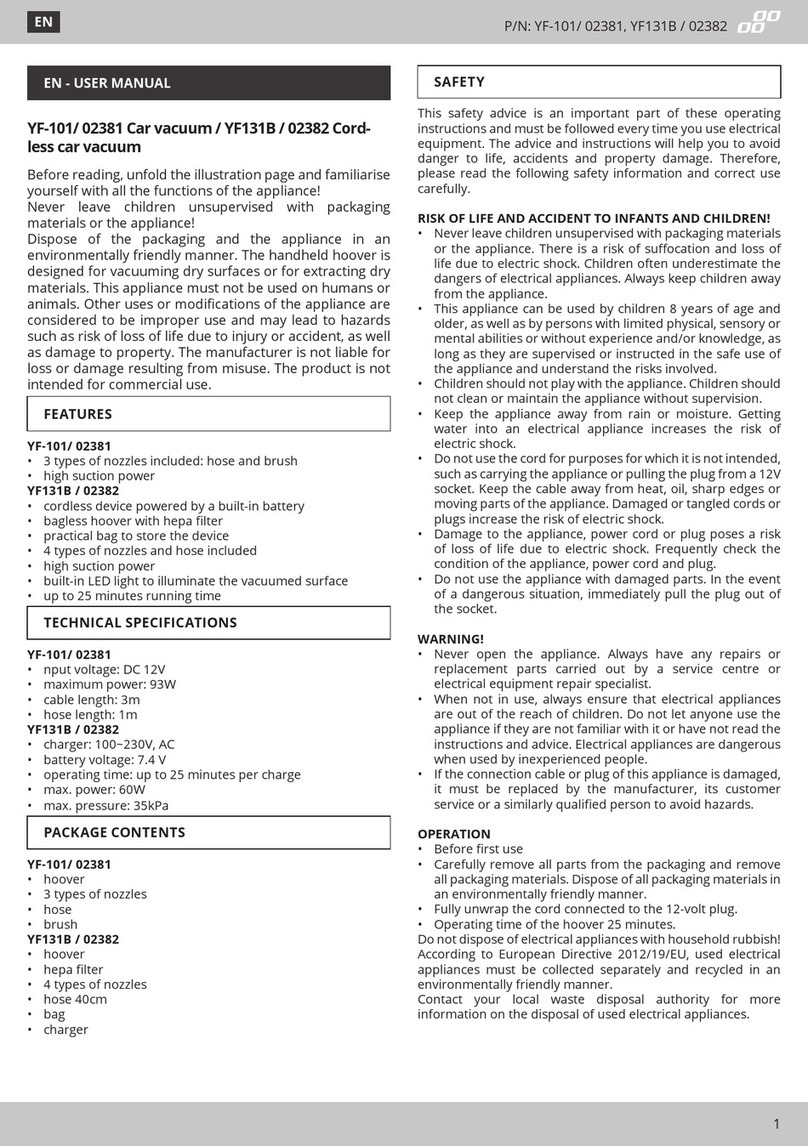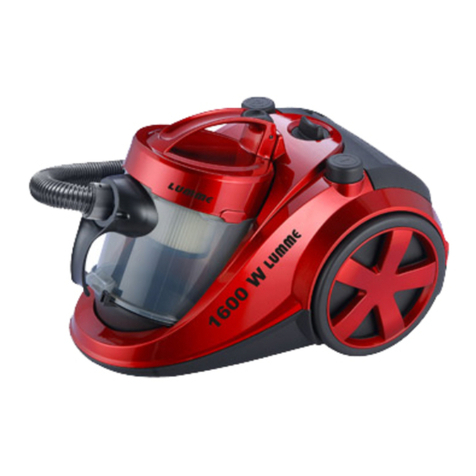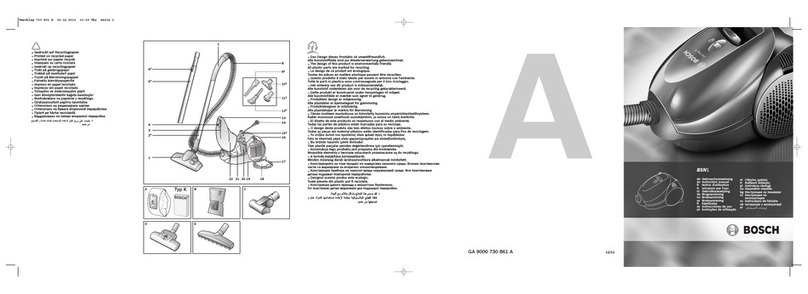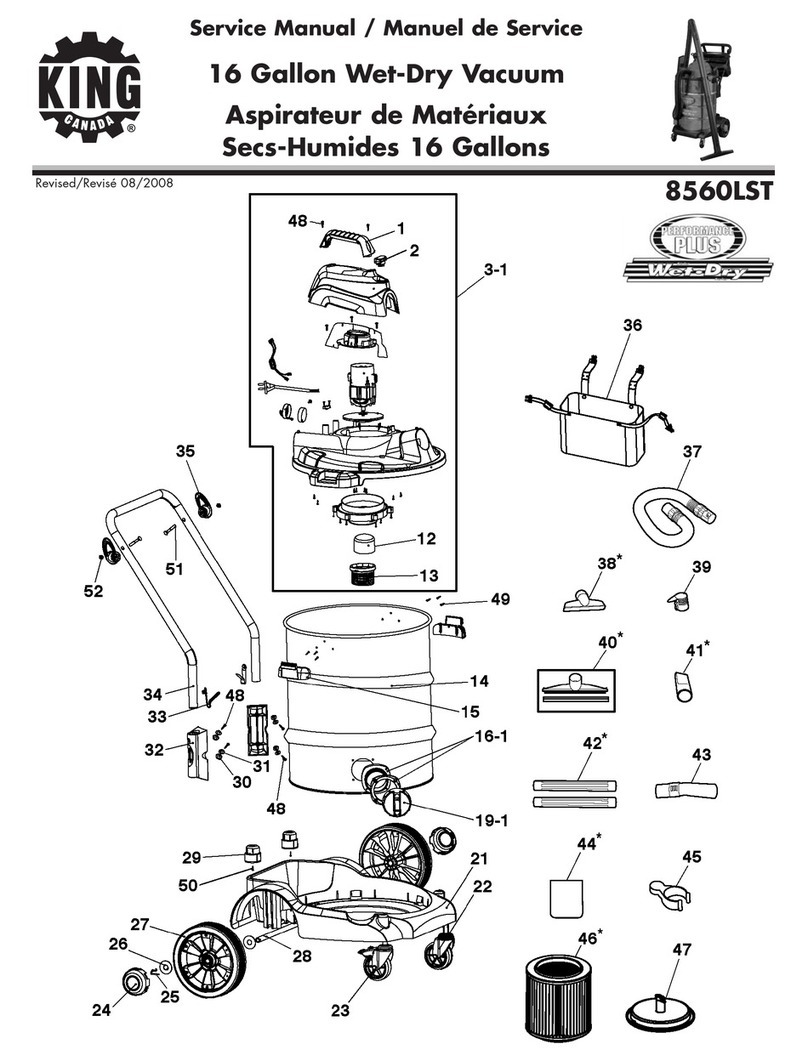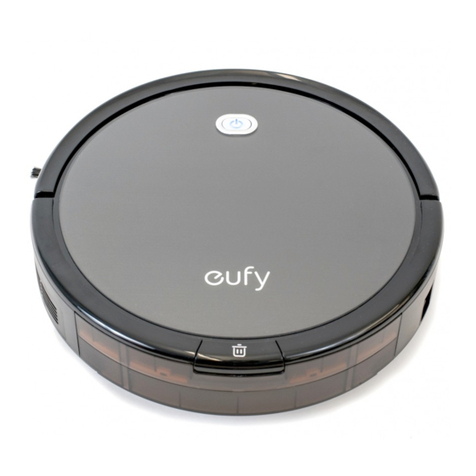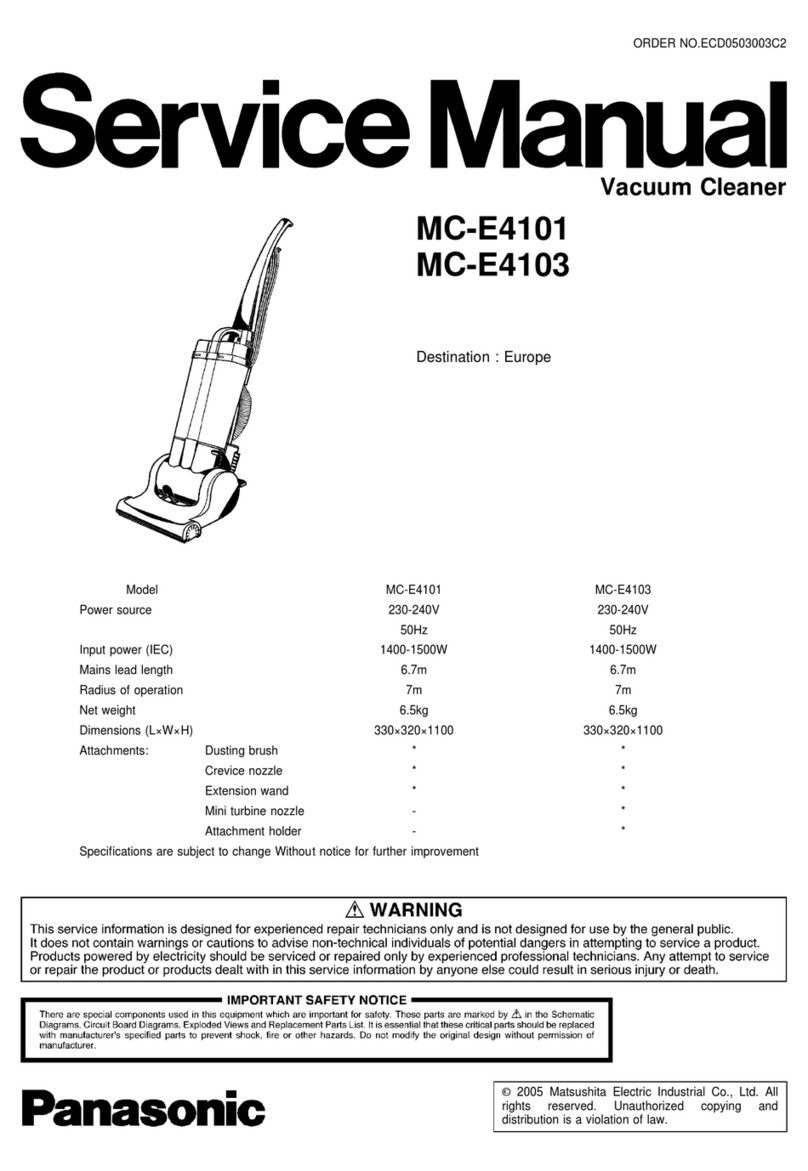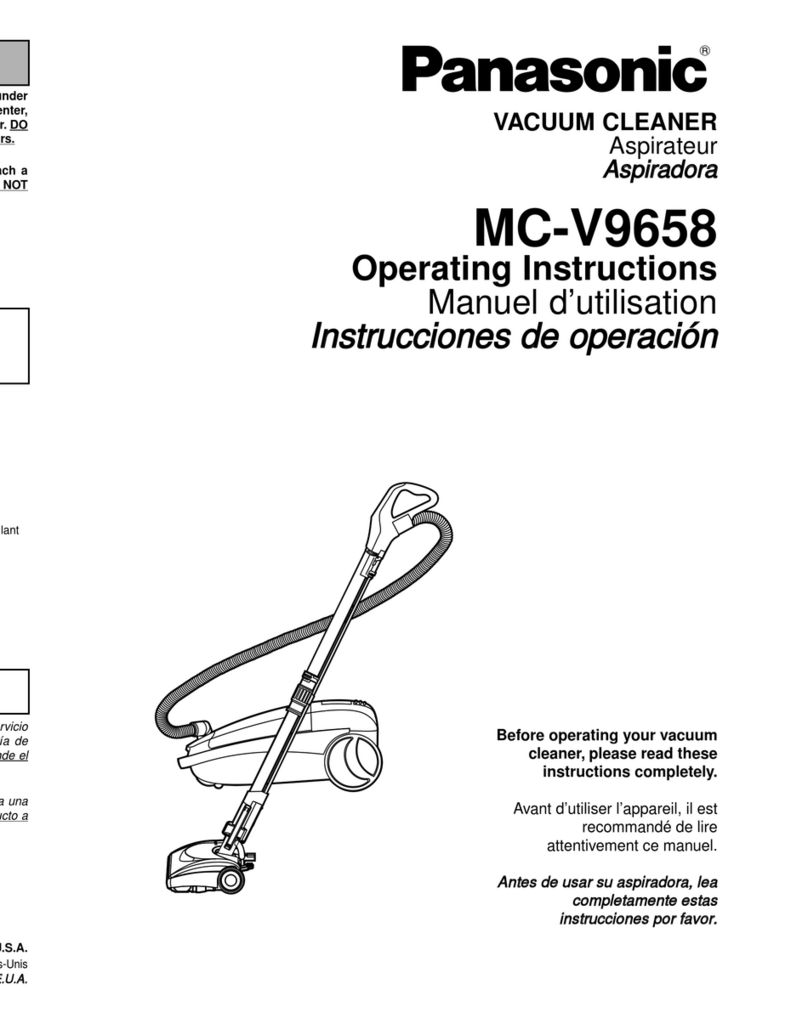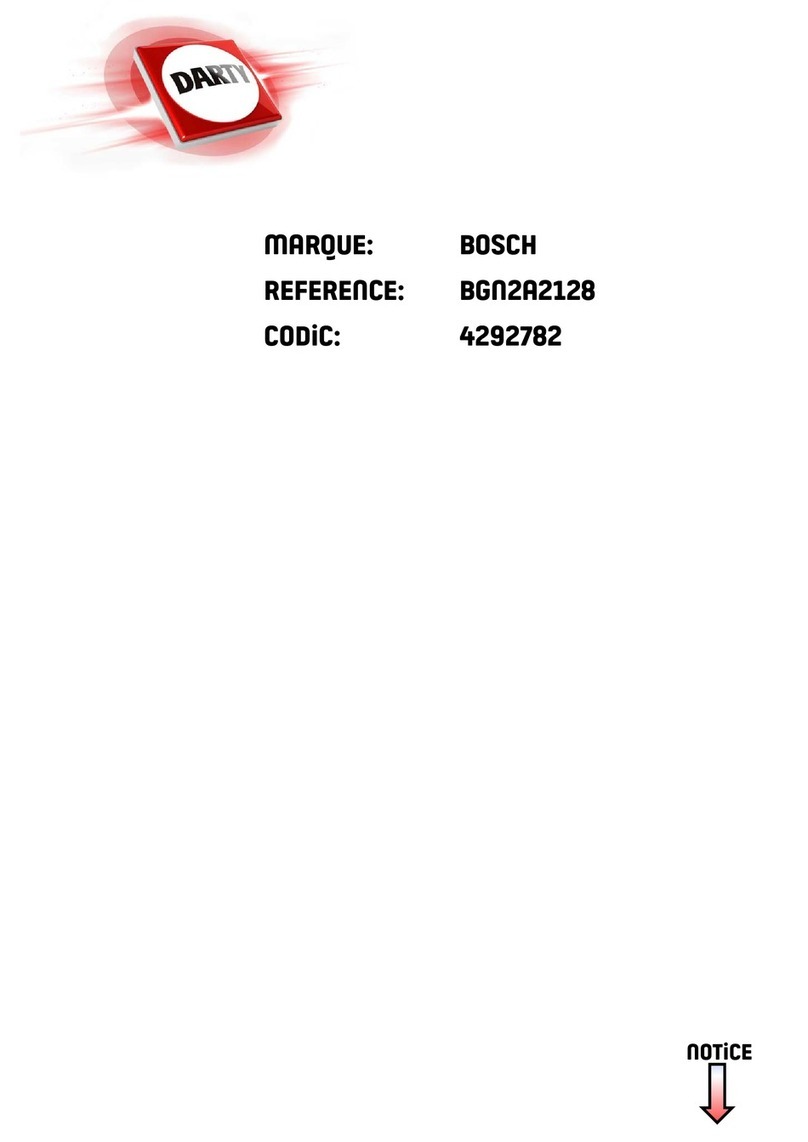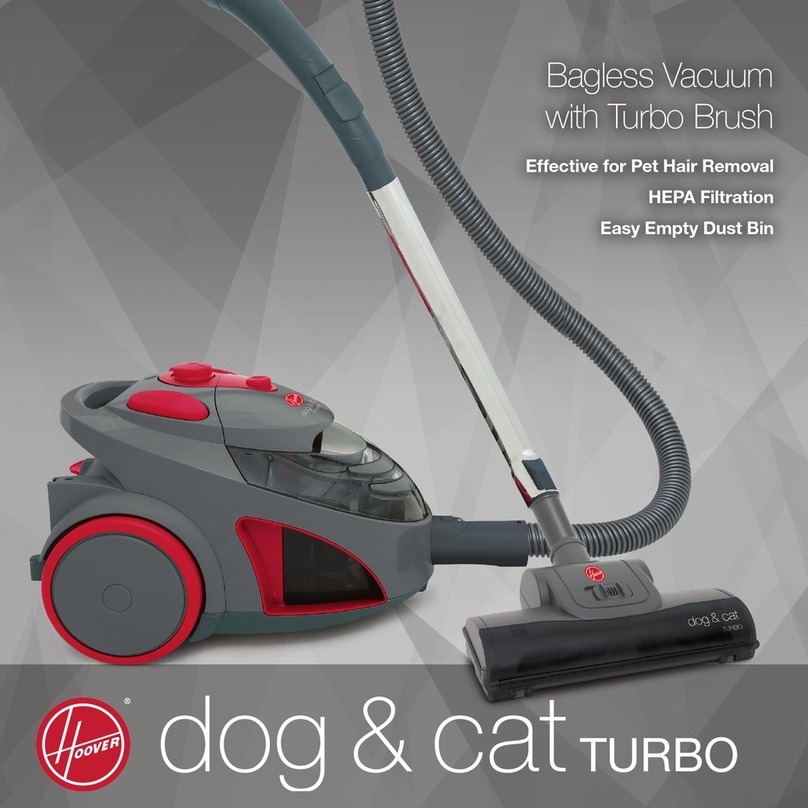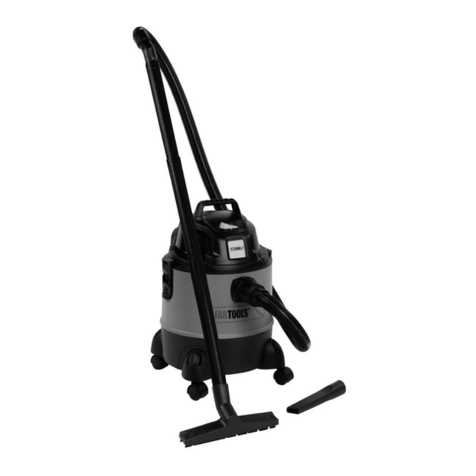
IMPORTANT!
Whenusingtheequipment,afewsafetyprecautionsmustbeobservedtoavoidinjuries
and damage. Please read the complete operating manual with due care. Keep this manual
inasafeplacesothattheinformationisavailableatalltimes.Ifyougivetheequipmenttoanyother
person,givethemtheseoperatinginstructionsaswell.
We cannot accept any liability for damage or accidents which arise due to a failure to follow these
instructions and the safety information.
• Do not leave appliance unattended when plugged in. Unplug from outlet when not in use and
before servicing and cleaning.
• Toavoidelectricshock,donotexposetorain.Storeindoors.
• Neveruseinthepresenceofexplosiveliquids,vapoursorexplosivedust–suchascoal
or grain.
• Never pick up asbestos or asbestos dust.
• Wooddustandchipsinaconnedareacangiverisetoreoranexplosion.Guardagainst
possible ignition sources.
• Donotpickupanythingthatisburningorsmouldering–suchasmetalgrindingdust,cigarette
ends,hotcoals,matchesorsimilar.
• Theapplianceisnottobeusedbypersons(includingchildren)withreducedphysical,sensory
ormentalcapabilities,orlackofexperienceandknowledge,unlesstheyhavebeengiven
supervision or instruction - children being supervised not to play with the appliance
• Use only manufacturer’s recommended attachments and consumables.
• Never modify the cleaner in any way - this is dangerous and will invalidate the warranty.
• Donotusecleanerwithoutthelterinplace.
• If motor sound becomes higher pitched always check for the following:
- Blocked hose or accessory.
-Blockedlter.
- Full container.
• Never try to move the cleaner by pulling with the mains lead.
• Alwayscheckthatthelterisclearandnotblocked.Keepallopeningsclearofanyblockages.
• Whenliftingtheunit,alwaysliftitwiththehandleorunderrimofbucket.Bewareofexcess
weight.
• Alwaysswitchtheunitobeforechangingattachmentsorconnectingdierentpowertools.
• Alwaysdisconnectequipmentfromtheappliancewhenitisnotinuse.
• If the cordset is damaged have it repaired by an authorised service centre.
• Thisapplianceisnotintendedforusebypersons(includingchildren)withreducedphysical,
sensoryormentalcapabilities,orlackofexperienceandknowledge,unlesstheyhavebeen
given supervision or instruction concerning use of the appliance by a person responsible for
their safety.
• Children should be supervised to ensure that they do not play with the appliance.
• The wet and dry vacuum cleaner is designed for wet and dry vacuuming using the appropriate
lter.Theapplianceisnotsuitableforthevacuumingofcombustible,explosiveorharmful
substances.
• Theequipmentistobeusedonlyforitsprescribedpurpose.Anyotheruseisdeemedtobea
case of misuse. The user / operator and not the manufacturer will be liable for any damage or
injuriesofanykindcausedasaresultofthis.
WET & DRY VACUUM SAFETY WARNINGS
WARNING! When using mains-powered tools, basic safety precautions, including
the following, should always be followed to reduce risk of re, electric shock,
personal injury and material damage.
Readthewholemanualcarefullyandmakesureyouknowhowtoswitchthetooloinan
emergency,beforeoperatingthetool.
Save these instructions and other documents supplied with this tool for future reference.
The electric motor has been designed for 230V and 240V only. Always check that the power
supply corresponds to the voltage on the rating plate.
Note: The supply of 230V and 240V on Ozito tools are interchangeable for Australia and
New Zealand.
Note: The power outlet used for the vacuum must be protected by a 30mA residual current device
or earth leakage circuit breaker.
Ifthesupplycordisdamaged,itmustbereplacedbyanelectricianorapowertoolrepairerin
order to avoid a hazard.
Note: Double insulation does not take the place of normal safety precautions when
operatingthistool.Theinsulationsystemisforaddedprotectionagainstinjuryresulting
from a possible electrical insulation failure within the tool.
Using an Extension Lead
Alwaysuseanapprovedextensionleadsuitableforthepowerinputofthistool.Beforeuse,
inspecttheextensionleadforsignsofdamage,wearandageing.Replacetheextensionleadif
damaged or defective.
Whenusinganextensionleadonareel,alwaysunwindtheleadcompletely.Useofanextension
lead not suitable for the power input of the tool or which is damaged or defective may result in a
riskofreandelectricshock.
WARNING! Read all safety warnings and all instructions. Failure to follow the
warningsandinstructionsmayresultinelectricshock,reand/orseriousinjury.
Save all warnings and instructions for future reference. The term “power tool” in the
warnings refers to your mains-operated (corded) power tool or battery-operated (cordless)
power tool.
1. Work area safety
a. Keep work area clean and well lit. Cluttered or dark areas invite accidents.
b.
Do not operate power tools in explosive atmospheres, such as in the presence of
ammable
liquids, gases or dust. Power tools create sparks which may ignite the dust or
fumes.
c. Keep children and bystanders away while operating a power tool. Distractions can cause
you to lose control.
2. Electrical safety
a. Power tool plugs must match the outlet. Never modify the plug in any way.
Do not use any adapter plugs with earthed (grounded) power tools.Unmodiedplugsand
matching outlets will reduce risk of electric shock.
b. Avoid body contact with earthed or grounded surfaces, such as pipes, radiators, ranges
and refrigerators. There is an increased risk of electric shock if your body is earthed or
grounded.
c. Do not expose power tools to rain or wet conditions. Water entering a power tool will
increase the risk of electric shock.
d. Do not abuse the cord. Never use the cord for carrying, pulling or unplugging the power
tool. Keep cord away from heat, oil, sharp edges or moving parts. Damaged or entangled
cords increase the risk of electric shock.
e. When operating a power tool outdoors, use an extension cord suitable for outdoor use.
Use of a cord suitable for outdoor use reduces the risk of electric shock.
f. If operating a power tool in a damp location is unavoidable, use a residual current device
(RCD) protected supply with a rated residual current of 30 mA or less. Use of an RCD
reduces the risk of electric shock.
3. Personal safety
a. Stay alert, watch what you are doing and use common sense when operating a power
tool. Do not use a power tool while you are tired or under the inuence of drugs, alcohol
or medication.
Amomentofinattentionwhileoperatingpowertoolsmayresultinseriouspersonalinjury.
b. Use personal protective equipment. Always wear eye protection.Protectiveequipment
suchasdustmask,non-skidsafetyshoes,hardhat,orhearingprotectionusedforappropriate
conditionswillreducepersonalinjuries.
c. Prevent unintentional starting. Ensure the switch is in the o-position before connecting
to power source and/or battery pack, picking up or carrying the tool. Carrying power
toolswithyourngerontheswitchorenergisingpowertoolsthathavetheswitchoninvites
accidents.
d. Remove any adjusting key or wrench before turning the power tool on.
Awrenchorakeyleftattachedtoarotatingpartofthepowertoolmayresultinpersonalinjury.
e. Do not overreach. Keep proper footing and balance at all times. This enables better control
of the power tool in unexpected situations.
f. Dress properly. Do not wear loose clothing or jewellery. Keep your hair, clothing and gloves
away from moving parts.Looseclothes,jewelleryorlonghaircanbecaughtinmovingparts.
g. If devices are provided for the connection of dust extraction and collection facilities,
ensure these are connected and properly used. Use of dust collection can reduce dust-
related hazards.
4. Power tool use and care
a. Do not force the power tool. Use the correct power tool for your application. The correct
powertoolwilldothejobbetterandsaferattherateforwhichitwasdesigned.
b. Do not use the power tool if the switch does not turn it on and o. Any power tool that
cannot be controlled with the switch is dangerous and must be repaired.
c. Disconnect the plug from the power source and/or the battery pack from the power tool
before making any adjustments, changing accessories, or storing power tools. Such
preventive safety measures reduce the risk of starting the power tool accidentally.
d. Store idle power tools out of the reach of children and do not allow persons unfamiliar
with the power tool or these instructions to operate the power tool. Power tools are
dangerous in the hands of untrained users.
e. Maintain power tools. Check for misalignment or binding of moving parts, breakage of
parts and any other condition that may aect the power tool’s operation. If damaged,
have the power tool repaired before use. Many accidents are caused by poorly maintained
power tools.
f. Keep cutting tools sharp and clean. Properly maintained cutting tools with sharp cutting
edges are less likely to bind and are easier to control.
g. Use the power tool, accessories and tool bits etc. in accordance with these instructions,
taking into account the working conditions and the work to be performed. Use of the
powertoolforoperationsdierentfromthoseintendedcouldresultinahazardoussituation.
h. Keep handles and grasping surfaces dry, clean and free from oil and grease. Slippery handles and
grasping surfaces do not allow for safe handling and control of the tool in unexpected situations.
5. Service
a. Have your power tool serviced by a qualied repair person using only identical
replacement parts. This will ensure that the safety of the power tool is maintained.
b. If the supply cord is damaged, it must be replaced by the manufacturer,
itsserviceagentorsimilarlyqualiedpersonsinordertoavoidahazard.
GENERAL POWER TOOL SAFETY WARNINGS
ELECTRICAL SAFETY
VVolts Hz Hertz
~Alternating current WWatts
ILitres Class II / Double
insulated
Regulator compliance
mark l/s Litres per second
Read instruction manual Warning
IP24 Ingress protection from
water mbar Pressure rating (millibar)
